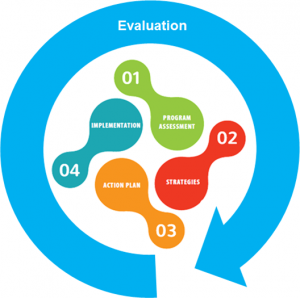The steps for implementing the Safe & Healthy Food Pantries Project are outlined below. You can adapt the strategies and tools presented in this guide so they are appropriate for your pantry – so be creative and identify what will work best for you!
Step 1: Assess your current food pantry operations with the Safe & Healthy Food Pantries Assessment tools. Use the results of these assessments to identify priority areas where you can make changes to the pantry environment and set goals. Not all areas will need to be addressed immediately and not all areas may be appropriate for your current pantry structure and operations. 
Step 2: Review the Safe and Healthy Food Pantry Strategies sections for research-informed recommendations and best practices for improving the food pantry environment. Once you are familiar with these strategies, move on to developing your Action Plan (Step 3) using the results of your program assessment (Step 1).
Step 3: Use the goals you set (Step 1) to develop an Action Plan that outlines the desired changes at the food pantry. Include in your plan actions your pantry is willing and able to implement from the Safe & Healthy Food Pantry Strategies section (Step 2). Develop written nutrition and food safety policies for the food pantry. These policies are critical tools for guiding, communicating and sustaining pantry nutrition and food safety operations.
Step 4: Implement the strategies identified in your Action Plan using the ideas and materials provided in the Safe and Healthy Food Pantry Strategies and Tools to Support You sections.
Step 5: Use the Action Plan (Step 3) to evaluate your efforts along the way.
Then, document your success by re-assessing your pantry operations. Regular assessments, at least once per year, allow the food pantry to evaluate progress in achieving your goals and success. Future Action Plans can be developed to sustain existing changes and expanded to incorporate new strategies for improving the food pantry environment.



